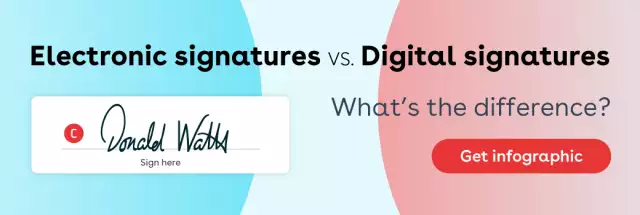
Electronic vs Digital Signatures: What are the Differences?

While the terms electronic signature and digital signature are often used interchangeably, they actually represent distinct technologies with varying levels of security, features, and functions. As a trusted name in eSignature and digital signature, we’d like to offer insights into some of the differences between electronic signatures and digital signatures to help you better understand which one better suits the needs of your business.
Electronic Signatures
Electronic signatures, often abbreviated as eSignatures, are a broad category of signatures that encompass a variety of methods used to sign documents electronically. An electronic signature is a legal concept that stands as lasting representation and capture of someone’s intent.
Electronic signature must prove:
- What was signed
- Intent and consent
- Who signed
They also offer:
- Convenience. eSignatures offer a quick and easy way to sign documents without the need for physical presence or printing.
- User-friendly. They are accessible and user-friendly, requiring minimal technical expertise.
- Versatility. eSignatures can be used for a wide range of documents, from contracts and agreements to simple authorization forms.
Digital Signatures
Digital signatures, on the other hand, are a specific type of electronic signature that support eSignatures. They are based on cryptographic technology, which ensures the integrity of the document and the identity of the signer. When a document is digitally signed, a unique digital fingerprint, or hash, of the document is generated. This process ensures that any alterations to the document are easily detectable, providing a robust level of security.
How digital signatures support electronic signatures:
- Secures sensitive data
- Detects tampering efforts
- Strengthens signer trust
Digital signatures offer:
- Enhanced security. They provide a strong layer of security, making them suitable for legally binding and sensitive documents.
- Tamper detection. Any changes made to a digitally signed document after signing will invalidate the signature, alerting all parties to potential tampering.
- Non-repudiation. Signers cannot later deny their involvement, as the digital signature provides proof of their identity and intent.
Simply having an electronic signature applied to a document doesn’t ensure integrity.
Better together
With the combination of eSignature supported by digital signature you get:
- Persuasive, legally binding evidence
- Peace of mind among all parties
- A significantly faster document workflow
Key differences
Technology: Electronic signatures encompass a broader range of methods, including simple scanned signatures and typed names. Digital signatures, on the other hand, rely on cryptographic technology to ensure document integrity and signer authenticity.
Security: While electronic signatures offer convenience, digital signatures provide a higher level of security through encryption and tamper detection.
Use cases: Electronic signatures are suitable for various everyday transactions and communications, whereas digital signatures are better suited for legally binding agreements, contracts, and other sensitive documents.
Legal validity: Both electronic and digital signatures are legally valid in many jurisdictions, but digital signatures often carry a higher presumption of authenticity due to their robust security measures.
Both electronic signatures and digital signatures play vital roles in streamlining and securing document processes. While electronic signatures offer convenience and versatility, digital signatures provide an additional level of security and authenticity, making them a preferred choice for important and legally binding documents. Understanding the differences between these two technologies empowers individuals and businesses to make informed decisions based on their specific needs, striking a balance between convenience and security in the world of digital documentation.



